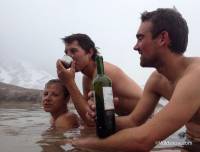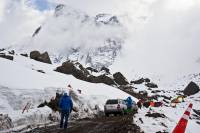
It’s not all skiing.. Hanging out in the muddy Banos Colina, with some delicious Chilean vino tinto.
Forget sunny beaches and tourist traps. Snowy corners of the world make for the best adventures. A ski bag and a strong trailbreaker are the finest travel companions. I’ve been to thirteen countries in my life, and touched skis to snow in twelve of them. I’m just what I’d call an “average good” skier, and I don’t have much money. I make up for it with a sense of adventure. Here’s some tips I’ve picked up from dragging my ski gear around the globe.
Be flexible.
It all comes down to conditions. Good skiing needs good snow. Period. Unlike climbing, hiking, or mountain biking, sunny weather isn’t ideal, but neither is a huge storm that traps you in your tent, van, or hotel room. It’s gotta be just right. Good conditions can be the difference between pow and breakable crust, and being safe or ruining your trip (and life) in an avalanche. In many areas there can be horrible conditions in one zone, and exceptional skiing just a short drive away. It’s incredibly hard to hit the perfect conditions first try; the solution is to be flexible.
As Bruce Lee would say: “Be water, my friend.”
Don’t book a hotel months in advance. Don’t pre-buy lift tickets that only work at one resort. I’ve found that only in the most crowded destinations is booking ahead necessary. If it’s that crowded, maybe check out somewhere a bit more off the beaten path. (In other words, always go equipped to sleep in your car!)
A flexible mindset is key to success.
If you’re doing a guided trip or tour, choose one that is flexible. Some companies are, others are regimented as to schedule. Ski touring or mountaineering trips are often an adventure from the start. You’ll probably have delays, problems, and unforeseen complications. Don’t get too flustered — just go with it. Missing a pow day is almost the end of the world, but not quite.
Find a good weather forecast, and pay attention to it.
Of course, if you’re going to be flexible, you need to know how to find the good stuff. Different weather forecasting systems work better for different areas.
NOAA is the go-to for the continental U.S.
I use Mountain Weather Forecast for many remote international locations.
In some areas, the local university can have some informative models and forecasts. Figure out a good site to get weather forecasts, as well as some that give current conditions and snow depth updates.
Many areas have either an active internet community, or a local alpine club that has a handle on conditions. Also, try to figure out on what different weather systems mean for the skiing in that particular area. For example, in the Alps, the dreaded Foehn wind often strips the Northern Alps dry, but the Italian Alps can have good conditions just a few hours away.
Plan for everything, including not having a plan.
Spontaneity is adventure, right? Yeah, but I’m the kind of guy who likes to have a plan, too. I try to balance having a plan with being flexible. In many ways, having some well-researched options can make you even more flexible.
Let’s say you’ve planned a 2-week visit to Portillo, you’re locked in. You land, drive up the switchbacks, and find all the epic pow you’ve seen on everyone’s Instagram has been blown into thin air by the Andean gales. If you are flexible, you have the opportunity to pack up and head somewhere else. However, you knew you were going to Portillo, so you didn’t do any research on anywhere else. You can’t get internet for whatever reason, so you’re stuck drinking beer and listening to rumors of storms in faraway places.
I like to do a bit of research on other areas and things, and have plans on top of plans. I love plans, but hate commitment, and for adventure travel that works out just fine.
Travel insurance.
Get it. Get the right plan. Many people skip out on travel insurance, or if they do purchase, they often only get the version that comes with their airline ticket. This is usually not the best deal. Research and find a suitable plan. It’s usually less than a hundred bucks, and is well worth it.
The first time I bought travel insurance was for my first international ski trip, to New Zealand. I busted my knee down there and the insurance was incredibly helpful. They paid the majority of the medical costs, and even popped for a first-class, last-minute flight back to the States. Not bad! Here’s a few things I keep in mind when choosing a plan:
1. It’s not just medical. Almost all plans have medical coverage, from what I’ve seen. That is the bare minimum. What really sets companies apart is their other benefits. You’ll often find these in “riders” available a la cart as you customize your plan. For example, we usually add the “extreme sports rider” to be sure we’re covered for mountaineering (and onsens).
2. The lost or stolen gear and baggage benefit has saved my butt several times. If you’re bringing expensive electronics, (such as a DSLR or laptop), make sure they are covered. Some companies cover theft up to several thousand dollars, but cap theft coverage for electronics at only a few hundred. If I’m taking my nice camera, that’s not going to work. In that case I go with a bit more expensive plan that has extensive coverage for electronics.
3. Another big perk is helping you out with lost baggage. Many plans will give you money to buy new ski gear at your destination if your baggage is lost. Look into how many days your bags have to be lost for this to kick in. Hanging out in the bar while your friends go skiing is horrible for your health.
4. Do they cover remote rescue? Some do, some don’t. Alpine clubs are often a good resource for remote rescue insurance. In some areas, such as Europe, you need to be the member of an alpine club to have free rescue (most are reciprocal).
The American Alpine Club has good (so I’ve heard) international rescue service Gobal Rescue as part of it’s membership. (Know that the default membership level in Global Rescue provided by AAC probably needs to be increased if you’re traveling in places without developed rescue services.)
We have several blog posts covering specifics about rescue insurance, and we’re keeping these updated.
Pack carefully.
Airline baggage fees are a bummer, but I’ve been able to do most my trips with only a carry on bag and a ski bag. Here’s how:
Be cheap.
I don’t have a ton of money, and wouldn’t be able to go on any trips without lots of scrimping and scrounging. Even if you’re loaded, being a little bit of a dirtbag can add to the adventure.
A few years ago in Chile, our crew spent a few nights in a 10×10 foot tin shack at the end of the road at the base of a 5,800 meter volcano. We spied the shack after a day of wonderful skiing, the door was open, and we decided to stay there. A bunch of the locals who built the place were there as well, and through our broken Spanish we learned a ton about skiing and climbing in the area, and had a great time. There was a nice lodge and hotel just 5 minutes down the road, but we never would have met those local hardmen without our stinginess.
Cheap backcountry ski trips are fairly easy to expedite. As backcountry skiers, we don’t need expensive ski passes. Just pick a spot and start skinning. If you’re already a backcountry skier, you probably don’t need much new gear, either. Plane tickets and other transportation are often a fixed cost. However, you can save money on lodging; opt for the hostel or spend a few nights snow camping. Find the cheapest car rental you can, and sleep in it. Ski bums slay the most pow, after all.
Be friendly.
Make friends with locals and other travelers. Hospitality is a universal value, you might just find someone willing to let you crash on their floor, or shred their pow stash.
Explore.
One of my favorite trips was a long road-trip to ski in the Torres Del Paine area of Chile. Although the area is well known for climbing and hiking, I have never heard of anyone else skiing there. There wasn’t much snow, and we had to carry our skis for two days to find it, but the skiing was actually pretty cool.
As long as there’s snow, you can ski just about anywhere. Unlike climbing or many other sports, you don’t need beta or a guidebook to ski somewhere. If you see an attractive slope in the distance, or on the map, go for it. Some of the coolest trips I’ve been on have been when we had absolutely no idea what to expect.
Don’t just ski.
Ski travel is really just an excuse to go to faraway places that you might not have chosen for a “normal” vacation. Eat food, check out local history, and figure out the native way to say cheers. Have fun, that’s the point.
Have high hopes, and low expectations.
The “perfect” ski trip involves many things going well: logistics, conditions, terrain. Often that doesn’t happen.
I don’t know if I’ve ever really found “perfection.” I’ve spent lots of time sitting inside, in the rain. Avalanche conditions have shut me down too often to count, and I should mention our weeks in a tent in Alaska when we shoveled way more snow than we skied.
Our trip to Greece last year had unequivocally dismal conditions. Almost all the ski areas in the country were closed, and the ones that were open had barely enough snow to cover the weeds. We could have been really bummed, but we weren’t. Everyone was friendly, and the food was incredible. We did lots of driving, managed to find some skiing, and had a blast. Remember, everyone else’s vacation doesn’t involve any skiing, none! They still have a good time, somehow, so why shouldn’t you?
So how about it, you readers have any ski travel tips? Which skin track leads to the best pow stash? How can Chilean wine be packed in a ski bag without breaking?
Louie Dawson earned his Bachelor Degree in Industrial Design from Western Washington University in 2014. When he’s not skiing Mount Baker or somewhere equally as snowy, he’s thinking about new products to make ski mountaineering more fun and safe.

